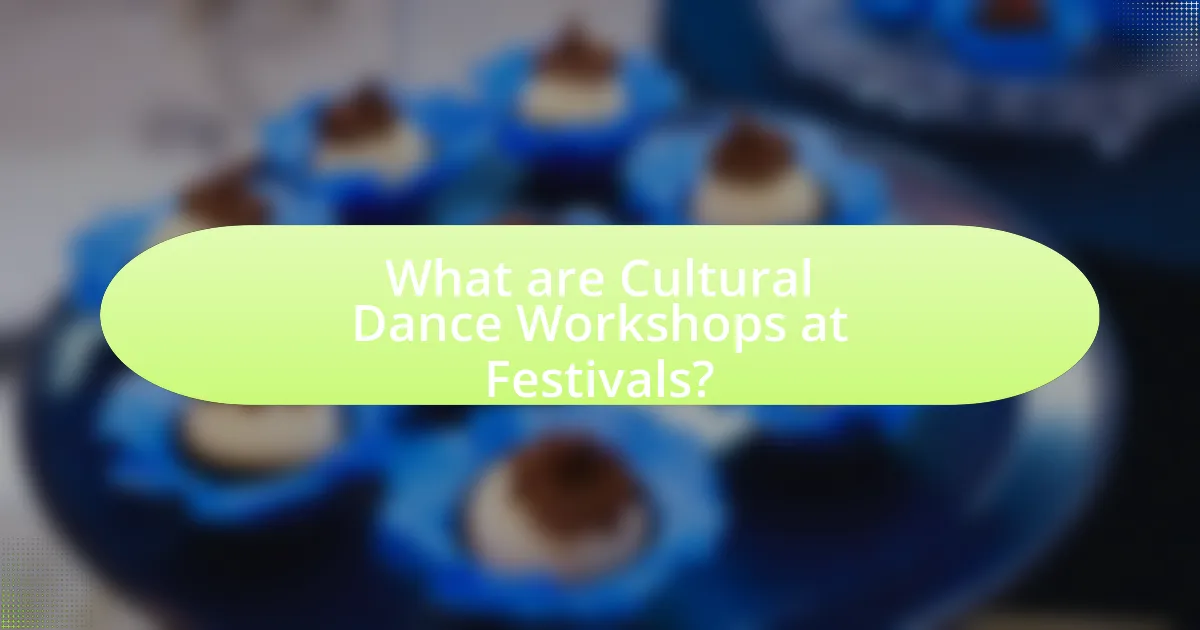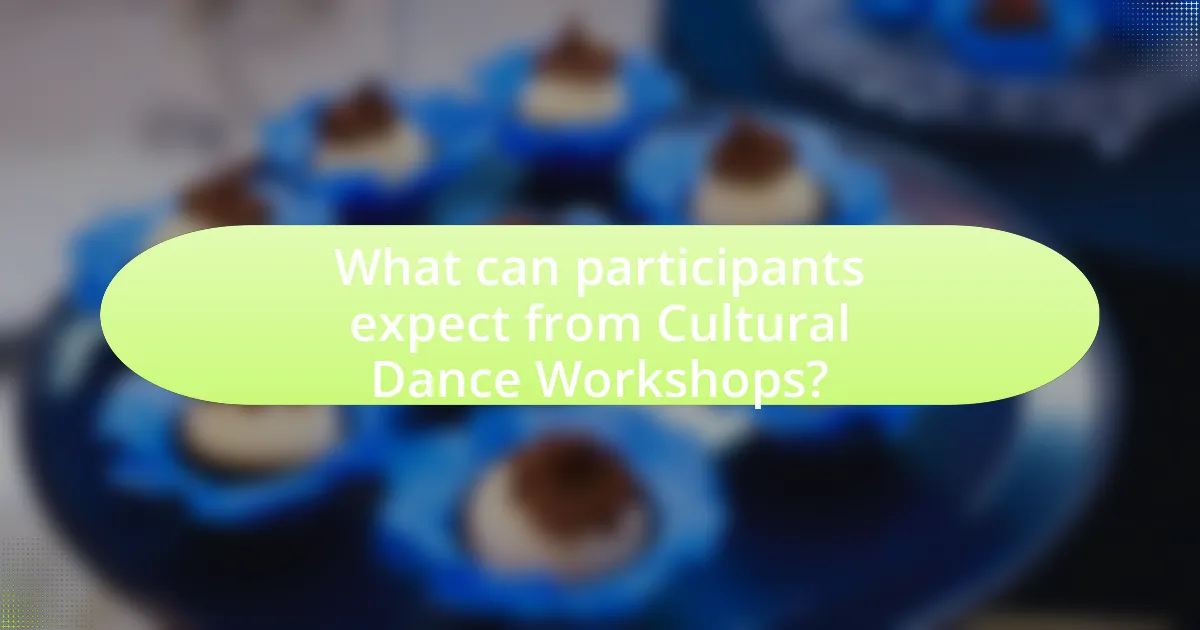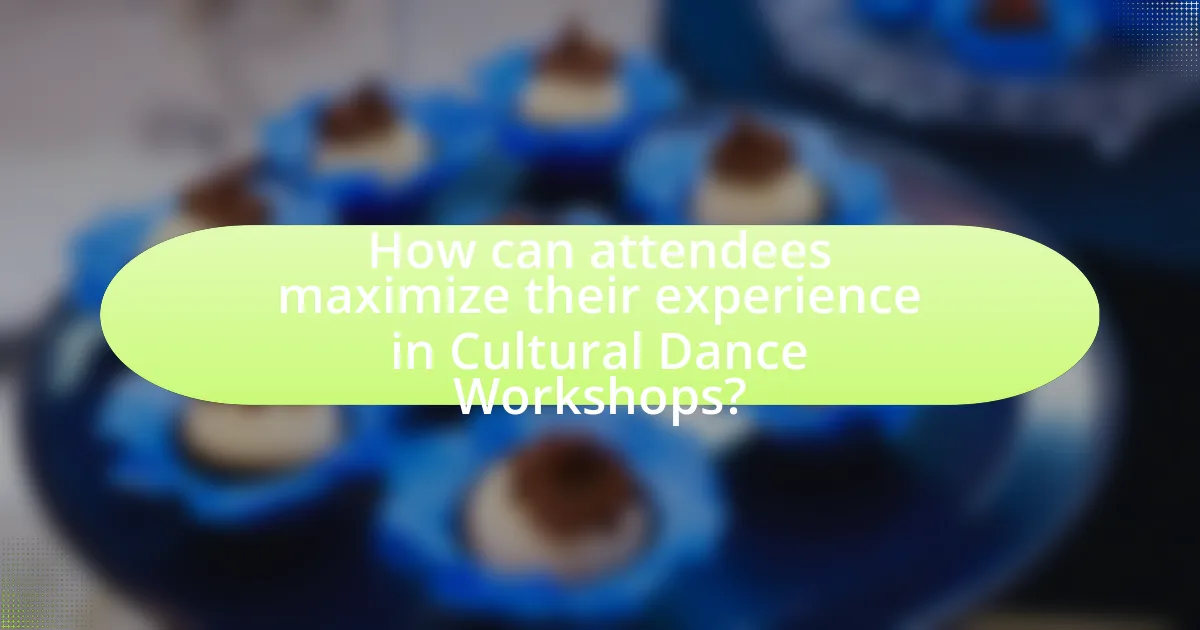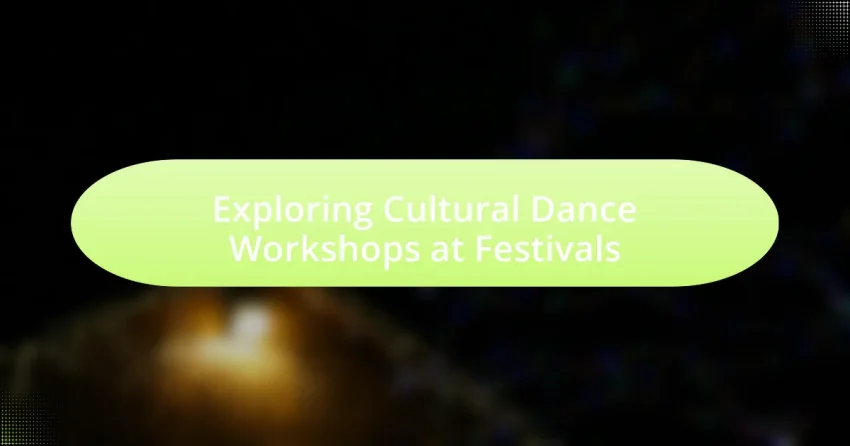Cultural dance workshops at festivals are interactive sessions designed to teach participants traditional dance forms that represent various cultures. These workshops, led by experienced instructors, not only provide hands-on learning experiences but also promote cultural exchange and community engagement. Participants can expect to learn about the cultural significance of dances such as Flamenco, Hula, and Bharatanatyam, while also benefiting from enhanced cultural awareness and social connections. The article explores the importance of these workshops for cultural preservation, community identity, and the overall festival experience, highlighting best practices for organizing them effectively.

What are Cultural Dance Workshops at Festivals?
Cultural dance workshops at festivals are interactive sessions where participants learn traditional dance forms representative of specific cultures. These workshops typically feature experienced instructors who guide attendees through the steps, techniques, and cultural significance of the dances. For example, festivals like the Smithsonian Folklife Festival often include workshops that showcase diverse cultural heritages, allowing participants to engage directly with the art form and its history. Such workshops not only promote cultural exchange but also enhance community engagement and appreciation for global traditions.
How do cultural dance workshops enhance festival experiences?
Cultural dance workshops enhance festival experiences by providing participants with immersive, hands-on learning opportunities that foster community engagement and cultural appreciation. These workshops allow attendees to actively participate in traditional dance forms, which deepens their understanding of the cultural significance behind the movements and music. Research indicates that engaging in cultural activities, such as dance, can lead to increased social cohesion and a sense of belonging among participants, as evidenced by studies showing that festivals featuring interactive cultural elements attract larger audiences and promote positive social interactions.
What types of cultural dance are typically featured in workshops?
Cultural dance workshops typically feature traditional dances such as Flamenco from Spain, Hula from Hawaii, Bharatanatyam from India, and African tribal dances. These workshops aim to educate participants about the cultural significance and techniques of each dance style. For instance, Flamenco incorporates intricate footwork and hand clapping, while Hula emphasizes storytelling through movement. The inclusion of these diverse dance forms in workshops reflects the rich heritage and artistic expression of various cultures, making them accessible to a broader audience.
How do participants benefit from engaging in these workshops?
Participants benefit from engaging in cultural dance workshops at festivals by gaining enhanced cultural awareness and social connections. These workshops provide hands-on experiences that allow individuals to learn about diverse traditions and practices, fostering appreciation for different cultures. Research indicates that participation in cultural activities can improve social cohesion and community engagement, as evidenced by a study published in the Journal of Cultural Sociology, which found that 78% of participants reported increased understanding of cultural diversity after attending such workshops. Additionally, participants often develop new skills in dance, which can boost confidence and promote physical well-being.
Why are cultural dance workshops important for cultural preservation?
Cultural dance workshops are important for cultural preservation because they actively engage participants in the transmission of traditional practices and values. These workshops serve as a platform for teaching and learning cultural dances, which are often integral to a community’s identity and heritage. By participating in these workshops, individuals not only gain skills in specific dance forms but also develop a deeper understanding of the cultural narratives and histories associated with them. Research indicates that such interactive experiences enhance cultural continuity, as evidenced by studies showing that communities with active dance programs report stronger connections to their cultural roots and increased participation in cultural events.
How do these workshops contribute to community identity?
Cultural dance workshops contribute to community identity by fostering a sense of belonging and shared heritage among participants. These workshops provide a platform for individuals to engage with their cultural traditions, enhancing communal ties through shared experiences and collective learning. For instance, studies have shown that participation in cultural activities, such as dance, strengthens social cohesion and promotes cultural pride, which are essential components of community identity. By actively involving community members in the preservation and celebration of their cultural practices, these workshops reinforce a collective identity that is rooted in shared history and values.
What role do festivals play in promoting cultural diversity through dance?
Festivals play a crucial role in promoting cultural diversity through dance by providing a platform for various cultural expressions and fostering intercultural dialogue. These events showcase traditional and contemporary dance forms from different cultures, allowing participants and audiences to experience and appreciate diverse artistic expressions. For instance, festivals like the Edinburgh Festival Fringe feature performances from over 50 countries, highlighting the rich tapestry of global dance traditions. This exposure not only educates attendees about different cultures but also encourages collaboration among artists from diverse backgrounds, thereby enhancing cultural exchange and understanding.

What can participants expect from Cultural Dance Workshops?
Participants can expect immersive experiences in Cultural Dance Workshops, where they will learn traditional dance forms from various cultures. These workshops typically include instruction on specific dance techniques, cultural context, and the significance of the dances within their respective communities. Participants often engage in hands-on practice, allowing them to develop skills while gaining insights into the cultural heritage associated with the dances. Additionally, workshops may feature live music, costumes, and opportunities for social interaction, enhancing the overall experience and fostering a deeper appreciation for cultural diversity.
How are workshops structured for different skill levels?
Workshops for different skill levels are structured by tailoring content and activities to meet the specific needs of beginners, intermediate, and advanced participants. For beginners, workshops typically focus on foundational techniques, basic movements, and introductory concepts, ensuring a supportive environment for learning. Intermediate workshops build on these basics, introducing more complex choreography and refining skills, while advanced workshops challenge participants with intricate routines and performance techniques. This tiered approach allows for progressive skill development, accommodating varying levels of experience and ensuring that all participants can engage meaningfully with the material.
What introductory techniques are taught to beginners?
Beginners in cultural dance workshops at festivals are typically taught foundational techniques such as basic footwork, rhythm patterns, and simple body movements specific to the dance style being explored. These techniques serve as the building blocks for more complex choreography and help participants develop a sense of timing and coordination. For example, in traditional folk dances, beginners may learn specific steps that are integral to the cultural context, allowing them to connect with the heritage of the dance.
What advanced skills can experienced dancers learn?
Experienced dancers can learn advanced skills such as improvisation, choreography creation, and fusion techniques. Improvisation allows dancers to express creativity spontaneously, enhancing their ability to adapt to various dance styles and music. Choreography creation involves the ability to design original dance sequences, which requires a deep understanding of movement dynamics and rhythm. Fusion techniques enable dancers to blend elements from different cultural dance forms, promoting versatility and cultural appreciation. These skills are often emphasized in cultural dance workshops at festivals, where experienced dancers can refine their artistry and expand their repertoire.
What materials or resources are typically provided during workshops?
Workshops typically provide materials such as instructional handouts, dance props, and audio-visual equipment. Instructional handouts offer participants detailed information about the dance styles being taught, including steps and cultural context. Dance props, such as scarves or instruments, enhance the learning experience by allowing participants to engage more fully with the dance. Audio-visual equipment, including speakers and projectors, is often used to play music or display instructional videos, facilitating a better understanding of the choreography and cultural significance. These resources collectively support the educational goals of cultural dance workshops at festivals.
Are there specific costumes or props used in cultural dance workshops?
Yes, specific costumes and props are used in cultural dance workshops. These costumes often reflect the cultural heritage and traditions of the dance form being taught, enhancing the authenticity of the experience. For example, traditional Indian dance workshops may utilize colorful sarees and intricate jewelry, while African dance workshops might include vibrant fabrics and masks. Props such as fans, sticks, or ribbons are also commonly incorporated to enrich the performance and engage participants. The use of these items not only aids in the learning process but also fosters a deeper connection to the cultural context of the dance.
What instructional materials are available for participants?
Participants in cultural dance workshops at festivals have access to a variety of instructional materials, including printed guides, video tutorials, and online resources. These materials are designed to enhance learning by providing step-by-step instructions, visual demonstrations, and cultural context for the dances being taught. For instance, printed guides often include choreography breakdowns and historical background, while video tutorials allow participants to see the movements in action, facilitating better understanding and practice.

How can attendees maximize their experience in Cultural Dance Workshops?
Attendees can maximize their experience in Cultural Dance Workshops by actively participating and engaging with the instructors and fellow participants. Engaging fully allows attendees to absorb techniques and cultural nuances effectively. Research indicates that immersive participation enhances learning outcomes, as seen in studies on experiential learning, which show that active involvement leads to better retention of skills and knowledge. Additionally, attendees should come prepared with an open mind and a willingness to learn, as this mindset fosters a more enriching experience.
What tips can enhance participation in these workshops?
To enhance participation in cultural dance workshops at festivals, organizers should create an inclusive and engaging environment. This can be achieved by promoting workshops through targeted marketing strategies that highlight the cultural significance and enjoyment of the dances, thereby attracting a diverse audience. Additionally, offering incentives such as free trial sessions or discounts for early registration can motivate potential participants to join. Research indicates that workshops with interactive elements, such as hands-on practice and opportunities for social interaction, significantly increase participant engagement and satisfaction. For instance, a study by the National Endowment for the Arts found that interactive arts experiences lead to higher levels of participant retention and enjoyment.
How should participants prepare physically and mentally for workshops?
Participants should prepare physically by engaging in regular exercise, focusing on flexibility, strength, and endurance, which are essential for dance activities. Additionally, maintaining a balanced diet and staying hydrated will enhance physical readiness. Mentally, participants should cultivate a positive mindset by practicing mindfulness techniques, such as meditation or visualization, to reduce anxiety and enhance focus. Research indicates that physical fitness improves overall performance in dance, while mental preparation techniques can significantly boost confidence and reduce stress levels, leading to a more enjoyable workshop experience.
What etiquette should be observed during cultural dance workshops?
During cultural dance workshops, participants should observe respect for the cultural origins of the dance, which includes understanding and honoring the traditions and practices associated with it. This respect is crucial as it fosters an inclusive environment and acknowledges the significance of the dance to its culture. Participants should also refrain from making inappropriate comments or jokes about the dance or its cultural context, as this can be disrespectful and offensive. Additionally, it is important to follow the instructions of the workshop leader, as they are often knowledgeable about the cultural significance and techniques of the dance. Engaging with fellow participants in a supportive manner enhances the learning experience and promotes a sense of community.
What are common challenges faced by participants in cultural dance workshops?
Participants in cultural dance workshops commonly face challenges such as physical limitations, cultural misunderstandings, and varying skill levels. Physical limitations can hinder participants’ ability to perform specific movements, which may lead to frustration. Cultural misunderstandings arise when participants are unfamiliar with the traditions and meanings behind the dances, potentially resulting in misinterpretation of the choreography. Additionally, varying skill levels among participants can create a disparity in learning, making it difficult for instructors to cater to everyone’s needs effectively. These challenges can impact the overall experience and learning outcomes in cultural dance workshops.
How can participants overcome language barriers in workshops?
Participants can overcome language barriers in workshops by utilizing translation tools and engaging in non-verbal communication methods. Translation apps, such as Google Translate, facilitate real-time communication, allowing participants to understand instructions and interact with others despite language differences. Additionally, non-verbal cues, such as gestures and visual aids, enhance understanding and foster collaboration among participants. Research indicates that non-verbal communication accounts for a significant portion of interpersonal interactions, making it an effective strategy in multilingual settings.
What strategies can help participants feel more comfortable in a group setting?
To help participants feel more comfortable in a group setting, facilitators can implement strategies such as creating an inclusive environment, encouraging open communication, and incorporating icebreaker activities. An inclusive environment fosters a sense of belonging, which is crucial for comfort; studies show that participants are more likely to engage when they feel accepted. Open communication allows individuals to express their thoughts and concerns, reducing anxiety and promoting trust among group members. Icebreaker activities, which have been shown to enhance group cohesion, can ease initial tension and encourage interaction, making participants feel more at ease.
What are the best practices for organizing Cultural Dance Workshops at Festivals?
The best practices for organizing Cultural Dance Workshops at Festivals include thorough planning, community engagement, and skilled instruction. Effective planning involves setting clear objectives, scheduling sessions at optimal times, and ensuring adequate space and resources for participants. Engaging with local cultural groups fosters authenticity and encourages participation, as these communities can provide valuable insights and promote the workshops. Additionally, hiring experienced instructors who are knowledgeable about the specific cultural dance forms enhances the quality of the workshops, ensuring that participants receive accurate and respectful instruction. These practices are supported by successful festival case studies, such as the Smithsonian Folklife Festival, which emphasizes community involvement and expert-led sessions to create enriching cultural experiences.
